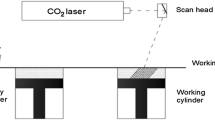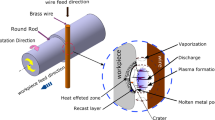Abstract
In this present study a multi response optimization method using Taguchi’s robust design approach is proposed for wire electrical discharge machining (WEDM) operations. Experimentation was planned as per Taguchi’s L16 orthogonal array. Each experiment has been performed under different cutting conditions of pulse on time, wire tension, delay time, wire feed speed, and ignition current intensity. Three responses namely material removal rate, surface roughness, and wire wear ratio have been considered for each experiment. The machining parameters are optimized with the multi response characteristics of the material removal rate, surface roughness, and wire wear ratio. Multi response S/N (MRSN) ratio was applied to measure the performance characteristics deviating from the actual value. Analysis of variance (ANOVA) is employed to identify the level of importance of the machining parameters on the multiple performance characteristics considered. Finally experimental confirmation was carried out to identify the effectiveness of this proposed method. A good improvement was obtained.
Similar content being viewed by others
References
McGeough JA (1988) Advanced methods of machining. Chapman and Hall, London
Spedding TA, Wang ZG (1997) Parametric optimization and surface characteristic of wire electrical discharge machining process. Precis Eng 20:5-15
Charmilles Technologies (1999) WEDM Charmilles Technologies manuals, 205960/E/ 25.09.1, Robofil 290, Geneva, Switzerland
Kozak J, Rajurkar KP, Wang SZ (1994) Material removal in WEDM of PCD Blanks. J Eng Ind 116:363–369
Spedding TA, Wang ZQ (1997) Study on modeling of wire EDM process. J Mater Process Technol 69:18–28
Scott D, Bovina S, Rajurkar KP (1991) Analysis and optimization of parameter combinations in wire electrical discharge machining. Int J Prod Res 29(11):2189–2207
Dauw DF, Albert L (1992) About the evolution of tool wears performance in wire EDM. Ann CIRP 41(1):221–225
Daniels ACM, Philps, Eindhoren (1976) NC wire spark erosion - a survey. Ann CIRP 25(2):521–525
Kinoshhita N, Fukui M, Gamo G (1976) Study on EDM with wire electrode; Gap phenomena. Ann CIRP 25(1):141–145
Tanimura T, Heuvelman CJ (1977) The properties of the servo gap sensor with spark-erosion machining. Ann CIRP 25(1):59–62
Kinoshhita N, Fukui M, Gamo G (1982) Control of wire –EDM preventing electrode from breaking. Ann CIRP 31(1):497–511
Tarng YS, Ma SC, Chung LK (1995) Determination of optimal cutting parameters in wire electrical discharge machining. Int J Mach Tools Manuf 35(12):1693–1701
Hsue WJ, Liao YS, Lu SS (1999) Fundamental geometry analysis of wire electrical discharge machining in corner cutting. Int J Mach Tools Manuf 39:651–667
Lin C-T, Chung I-F, Huang S-Y (2001) Improvement of machining accuracy by fuzzy logic at corner parts for wire-EDM. Fuzzy Sets Syst 122:499–511
Qu J, Shih AJ, Scattergood RO (2002) Development of the cylindrical wire electrical discharge machining process, part 1: concept, design, and material removal rate. J Manuf Sci Eng 124:702–707
Qu J, Shih AJ, Scattergood RO (2002) Development of the cylindrical wire electrical discharge machining process, part 2: concept, design, and material removal rate. J Manuf Sci Eng 124:708–714
Gokler MI, Ozanozgu AM (2000) Experimental investigation of effects of cutting parameters on surface roughness in the WEDM process. Int J Mach Tools Manuf 40:1831–1848
Puri AB, Bhattacharyya B (2003) An analysis and optimization of the geometrical inaccuracy due to wire lag phenomenon in WEDM. Int J Mach Tools Manuf 43:151–159
Ramakrishnan R, Karunamoorthy L (2004) Surface roughness model for CNC wire electro discharge machining. J Manuf Technol Today 3(5):8–11
Ramakrishnan R, Karunamoorthy L, sudhesh R, Kayalvizhi C (2003) Parametric optimization of CNC wire cut EDM based on Taguchi methodology. Proc 6th International Conference on APORS – 2003, pp 579–590
Ramasamy H, Blunt L (2002) 3D surface characterization of electro polished EDMed surface and quantitative assessment of process variables using Taguchi methodology. Int J Mach Tools Manuf 42:1129–1133
Nian CY, Yang WH, Tarng YS (1999) Optimization of turning operations with multiple performance characteristics. J Mater Process Technol 95:90–96
Author information
Authors and Affiliations
Corresponding author
Rights and permissions
About this article
Cite this article
Ramakrishnan, R., Karunamoorthy, L. Multi response optimization of wire EDM operations using robust design of experiments. Int J Adv Manuf Technol 29, 105–112 (2006). https://doi.org/10.1007/s00170-004-2496-6
Received:
Accepted:
Published:
Issue Date:
DOI: https://doi.org/10.1007/s00170-004-2496-6




